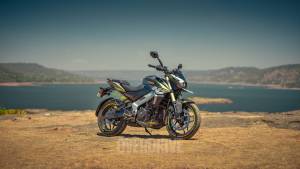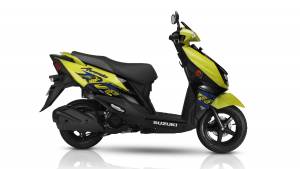2012 Royal Enfield Thunderbird 500 in India road test

It was a long first ride by any standard and the November tour and story should have brought home how far Royal Enfield have come. And how much ground remains to be covered. But bike launches can be 'designed' to show off the best facets of a product while not really allowing the chinks in the armour to appear, either due to the shortness of the experience, or due to the selection of the riding environment.
Sounds ominous? The fact of the matter is that the despite everything said about the motorcycle, the Thunderbird is an urban creature. Most will get used for commuting, to go to the shops and other flavours of daily chores that motorcycles are often tasked with. A smaller number will see the weekend rides and the finest, most minuscule slice will head down the highway and log impressive miles that will mark the rider as a certified bike nut. How does the TB500 acquit itself at these roles? Let us find out.
Design, build and finish
RE has never been accused of giving sleepless nights to Honda by setting new benchmarks on fit, build and finish, and that hasn't changed. But that being said, the TB500 is definitely an improvement over any RE motorcycle you care to name in most ways.
In terms of design, the original Thunderbird was slightly gawky and so is this one. The bigger tank does work visually with the black engine and we have gotten used to the proximity of long, gangly looking front forks (now fatter and better for it, visually and otherwise) and the extravagance of the chrome twin-pod instruments. The instruments themselves look neat to the eye, but I think more differentiaton between the speedo and tacho would have made reading them at a glance easier - especially for people who are just borrowing the bike for a short spin. But looking aft, the side panel is the only bit that fits in. The rear fender has no friends at this party and as much as I like the idea of the LED tail lamp from a functional perspective, it too is dressed oddly.
Similarly, many of the new features and equipment could be better. The scalloped seat as I mentioned in the first ride may fit the look but that's really the bit that's cutting down the highway range of the motorcycle. Even in the city, there were times when a 20-minute crawl in heavy traffic would make me intensely aware of my tail bone. Both seats release easily thanks to wire loops (think Pulsar seat from a generation or two ago). But getting to the loops is a bit fiddly. Vastly better than anything RE has done before, but crying out loud for a more elegant solution. Similar niggles exist elsewhere too. The shorter sissy bar may look more in sync with the motorcycle, but it does basically nothing for the pillion. Who also, happens to get, really snug accommodation.
But when you notice how much effort has gone into the motorcycle and how it compares to its siblings, you realise that you are looking in at a motorcycle that marks a step forward but not the end of the journey.
I liked the detail in the footpegs and the RE logos sprinkled here and there across the bike. The TB500 does maintain a direct link to its predecessor in design but takes significant steps forward in fit-finish and build. There are design details that need more work, but the TB500 is the clearest sign of progress and forward motion at RE, I have seen in the past thirteen years in the business.
Engine, performance and economy
The TB500 uses the same engine as the Classic 500, which means it is smooth and fuel-injected, at certain speeds. The engine is a stressed member of the chassis which is one of the reasons that Enfields cannot suppress vibration entirely. On the TB500, the bars remain more or less steady at all speeds, but the footpegs betray engine speeds easily. RE is mounting the pegs on a new subframe though, so I'd imagine it should be possible to rubber mount the pegs. Worse though are the vibes in the pillion pegs at high speeds.
But this is an Enfield engine, which means loads of torque, easy cruising in town and smooth 80-90kmph on the highway. 120-130kmph, indicated, is possible but will make your engine clattery.
The gearshifts are still not perfect - the shifts are notchy, can be more positive and require considerable effort. But again, these are standard elements of the Enfield experience. And the elements you will appreciate is the easy nature of the engine's performance, its sweet torque delivery, the thump (you'll have to release it from the clutches of the Indian noise norms, of course) and on the TB500, that sense of the 85kmph lope that will easily give you 500km to the tankful as promised.
To put numbers on it, the TB manages 60kmph in 5.57s, 100kmph in 15.35s and tops out at 119.32kmph (which shows up as about 130kmph on the speedo). On our economy test, the TB500 did reasonably well, clocking 33.20kmpl in the city and 37.41kmpl on the highway.
Ride, handling and braking
This is the area where the TB500 has improved the most. The changes are a new swingarm and thicker (and therefore stiffer) front forks more or less, but they make a massive, massive difference. The TB500 was able to absorb, without fuss, large bumpy sections that I expected it to struggle with. It isn't as slick and controlled as say, the CBR250R or anywhere close to our current ride benchmark, the Impulse, but if you'd told me this ride quality was possible on an Enfield I'd have had trouble believing you until I tested the TB500.
The handling, similarly, is far more assured, taut and responsive than before. The forks and the swingarm give the chassis the strength to respond to violent, sharp steering inputs with an eagerness that I haven't seen before on any Enfield and I suspect these bits will find their way to the rest of the range and all of the Chennai motorcycles will benefit from them.
Unfortunately, this parameter set isn't without issue either. The feel of the chassis now show the tyres up as unequal to the task and while in normal riding these are grippy, durable tyres, in hard cornering mode they aren't sticky enough. And on the brakes, they make the front judder and on the brakes is where the TB500 feels dynamically the weakest. And this bears out in our brake test, the TB500 takes 5.07s to come to a stop from 100kmph which is one of the worst braking performances we have recorded in the recent times. The rear disc brake and the weight distribution of the motorcycle do allow decent stops from speed, but modern disc brakes can do far, far better. And uncompromisingly, modern, sticky rubber will do the motorcycle a whole galaxy of favours.
Verdict
If I were to evaluate the TB500 without any context other than it being on sale in 2012 with its current spec and its price of Rs 1.82 lakh on-road, I'd have to admit that there is potential here but unrealised. For it to be an effective highway motorcycle, the engine must pass on less vibration to the rider, the ride has to feel more plush at the saddle, the saddle needs to be more posterior friendly on longer riding days and overall, the motorcycle has to go about its business requiring less effort overall from the rider - from the actuation of the clutch, to changing gears onwards. For the money, there are vastly better motorcycles you can buy in India today. But give it the context and history it sits at the head of, look at it through the eyes of someone who is steeped in the brand's appeal and story and the picture is vastly rosier. Then the TB500 represents - until the Cafe Racer arrives next year - the sparkly new pinnacle of Bullet-dom. It's the best motorcycle the company makes in many ways and definitely worth queuing up for. Me? I'm going to wait for the Cafe Racer and see if it can entice me into owning my first Enfield ever.
Related Stories
Top Stories
Latest Videos
Most Popular
Network18 Updates












